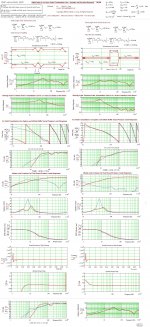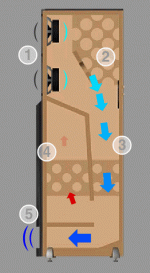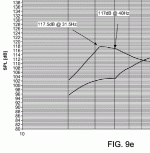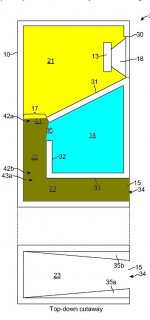I din't want to ask this question in the Holliman thread and disrupt it
but does anybody have any knowledge or experience of the system
in my heading to this thread. If its been around since 2009 there should
be some evidence of whether it works or is just hype by now.
jamikl
but does anybody have any knowledge or experience of the system
in my heading to this thread. If its been around since 2009 there should
be some evidence of whether it works or is just hype by now.
jamikl
I din't want to ask this question in the Holliman thread and disrupt it
but does anybody have any knowledge or experience of the system
in my heading to this thread. If its been around since 2009 there should
be some evidence of whether it works or is just hype by now.
jamikl
Hi, Read about the hyped speaker here:
Test Report: Atlantic Technology AT-1 H-PAS Speakers | Sound and Vision Magazine
Compare with this sub(insane😀 but similar airways) suggestion (to be hidden in a small closet):
b🙂
Attachments
From recent posts to the Yahoo Quarter Wavelength Loudspeaker Design forum:
http://us.mg4.mail.yahoo.com/dc/launch?.gx=1&.rand=8olo2qpop5bbg
//
There is a technology that is being released in commercial form that "may" approach what you describe.
http://www.gspr. com/atlantic/ hpas.html
Phil Clements was a judge and speaker at this year's MWAF
http://www.midwesta udiofest. com/index. php
Mr. Clements made mention of having "development" assistance from someone who frequents this forum...
//
http://www.stereoph ile.com/fsi2007/ 041507vivace/ index.html
http://www.6moons. com/audioreviews /gemmeaudio2/ vivace.html
http://www.stereomo jo.com/Gemme% 20Audio%20Vivace %20Speaker% 20Review/ GemmeVivaceSpeak erReviewA. htm
http://www.avguide. com/review/ gemme-audio- vivace-loudspeak er
http://www.tone. co.nz/reviews/ gemme-audio- vivace-floorstan ding-loudspeaker s-79
//
From Martin King:
"Atlantic Technology is using custom versions of my MathCad worksheets to
design the H-PAS enclosures. I wrote the worksheets for them and they are
doing all of the design work. Can't say much more."
http://us.mg4.mail.yahoo.com/dc/launch?.gx=1&.rand=8olo2qpop5bbg
//
There is a technology that is being released in commercial form that "may" approach what you describe.
http://www.gspr. com/atlantic/ hpas.html
Phil Clements was a judge and speaker at this year's MWAF
http://www.midwesta udiofest. com/index. php
Mr. Clements made mention of having "development" assistance from someone who frequents this forum...
//
http://www.stereoph ile.com/fsi2007/ 041507vivace/ index.html
http://www.6moons. com/audioreviews /gemmeaudio2/ vivace.html
http://www.stereomo jo.com/Gemme% 20Audio%20Vivace %20Speaker% 20Review/ GemmeVivaceSpeak erReviewA. htm
http://www.avguide. com/review/ gemme-audio- vivace-loudspeak er
http://www.tone. co.nz/reviews/ gemme-audio- vivace-floorstan ding-loudspeaker s-79
//
From Martin King:
"Atlantic Technology is using custom versions of my MathCad worksheets to
design the H-PAS enclosures. I wrote the worksheets for them and they are
doing all of the design work. Can't say much more."
At the end of the speaker judging competition, I spoke with Mr. Clements about the technology. He was engaging, however his conversation used terms which I did not find useful.
He knew he was in a group of people who design and build speakers.
His focus is the support and marketing of the technology through commercial efforts.
I don't expect he will let the "secret" out for awhile...
He knew he was in a group of people who design and build speakers.
His focus is the support and marketing of the technology through commercial efforts.
I don't expect he will let the "secret" out for awhile...
Isn't the 'secret' that it is just a TL, but with a 'jug' that resonates and adds like the holliman, and not as a helmholtz that reduces?
quote: "that serves to null the unwanted primary resonances of the main line." kinda sounds iffy to me...
quote: "that serves to null the unwanted primary resonances of the main line." kinda sounds iffy to me...
After 40 years interest in building loudspeakers and reading everything available. I am -sorry to say again- totally unimpressed. I cannot recall how often I have read about "modified" TLS concepts. Usually there is very little new under the sun..
The German magazine "Klang und Ton" pioneered TLS systems with an internal Helmholtz resonator to absorb the nulls in the line, effecitively flattening the response above, say, 80 Hz.
And now this..Furthermore the whole idea seems to carry shades of a rather unique design of the early eighties by an American company called Phase Research. No Prior Art, as required for a patent, I have my doubts.
Transmission Line speaker design has always been surrounded by all sorts of mysticism. Have built half a dozen, I can only say there is no magic to them, other then ending up with a pretty large speaker.
One of the great insights recent literature (Toole, Welti, Geddes, Double Bass Array et al.) has given is that proper room placement (maybe plus optional Digital Room Correction) is far more important than any particular woofer loading technique.
My five cents.
Eelco
The German magazine "Klang und Ton" pioneered TLS systems with an internal Helmholtz resonator to absorb the nulls in the line, effecitively flattening the response above, say, 80 Hz.
And now this..Furthermore the whole idea seems to carry shades of a rather unique design of the early eighties by an American company called Phase Research. No Prior Art, as required for a patent, I have my doubts.
Transmission Line speaker design has always been surrounded by all sorts of mysticism. Have built half a dozen, I can only say there is no magic to them, other then ending up with a pretty large speaker.
One of the great insights recent literature (Toole, Welti, Geddes, Double Bass Array et al.) has given is that proper room placement (maybe plus optional Digital Room Correction) is far more important than any particular woofer loading technique.
My five cents.
Eelco
@ jamikl
Thanks for posting about this 🙂 as i hadn't heard of it before 🙁
Also thanks to those that have provided more info/links etc 🙂 Here's some from me.
Phil Clements, originally of Phase Research, invented the basic concept about thirty years ago. So once again it seems not much is new ! What interests me the most, is the claim of inverse rolloff below fs to f3.
*
See an animation of the design http://www.atlantictechnology.com/Upload/flash/H-PAS_animation_final.swf
Thanks for posting about this 🙂 as i hadn't heard of it before 🙁
Also thanks to those that have provided more info/links etc 🙂 Here's some from me.
Phil Clements, originally of Phase Research, invented the basic concept about thirty years ago. So once again it seems not much is new ! What interests me the most, is the claim of inverse rolloff below fs to f3.
Hello:
My name is Philip Clements, Inventor of “H-PAS” loudspeaker technology, the future of sound and loudspeaker sound reproduction technology, today. If one of your passions in life includes listening to and being moved by good music and/or enjoying great home theater video and sound, you will probably be hearing and reading a great deal about “H-PAS”, patent pending. Google “H-PAS” speaker technology even today and you will probably get a quarter million hits on just its beginning over the past year. The following descriptions and information are offered to those with interest in hopes of providing a little greater understanding of what the technology is, what it does to enhance sound enjoyment, and what it means for almost all the sound applications and uses of sound we enjoy today and will in the future.
New Page 2
*
See an animation of the design http://www.atlantictechnology.com/Upload/flash/H-PAS_animation_final.swf
Attachments
Thanks for the replies and links, some of which I have seen.. It seems to
have been around as a [product since 2009 but it does not seem to have shattered the earth in any way which is why I would like to get beyond the hype
and find out if there is anything there. Just like the Holliman I guess that there are those who believe and those who don't. What seems to separate this from the Holliman is that the H-Pas may be in production.
Have you tried the second one out bjorno?
I took it the other way jbell, that the "jug" is an absorber to smooth the line resonances or harmonics but I don't know much 🙂
jamikl
have been around as a [product since 2009 but it does not seem to have shattered the earth in any way which is why I would like to get beyond the hype
and find out if there is anything there. Just like the Holliman I guess that there are those who believe and those who don't. What seems to separate this from the Holliman is that the H-Pas may be in production.
Have you tried the second one out bjorno?
I took it the other way jbell, that the "jug" is an absorber to smooth the line resonances or harmonics but I don't know much 🙂
jamikl
Last edited:
The enclosure looks like a normal reverse tapered TL. I can't see
how it any different so his explanation on the link New Page 2 should
apply to any such TL if he is right. The "jug" appears to be at one
fifth of the line length, maybe one third even, and the speakers
at the end. The "jug" is where you might mount the speakers
in another design, although this would normally be done at the
end of the first fifth (third) rather than the last fifth(third). At
such low frequencies do the fundamental waves see the jug as
anything but an extension of the line?
jamikl
how it any different so his explanation on the link New Page 2 should
apply to any such TL if he is right. The "jug" appears to be at one
fifth of the line length, maybe one third even, and the speakers
at the end. The "jug" is where you might mount the speakers
in another design, although this would normally be done at the
end of the first fifth (third) rather than the last fifth(third). At
such low frequencies do the fundamental waves see the jug as
anything but an extension of the line?
jamikl
Last edited:
I took it the other way jbell, that the "jug" is an absorber to smooth the line resonances or harmonics but I don't know much 🙂
jamikl
It very well could be... however there are other simple ways to smooth a response spike, like danley does with a bit of pvc pipe in some of his TH.
However if that is all the h-pas has going for it -- I'd have to agree with the post above -- it's nothing remarkable.
Hi jbell,
I agree it looks like there is nothing really new here, but what's remarkable is that we can just simulate enclosures like that without having to resort to who knows how many trial builds thanks to the math wizards and the computer.
Regards,
I agree it looks like there is nothing really new here, but what's remarkable is that we can just simulate enclosures like that without having to resort to who knows how many trial builds thanks to the math wizards and the computer.
Regards,
Isn't the 'secret' that it is just a TL, but with a 'jug' that resonates and adds like the holliman, and not as a helmholtz that reduces?
quote: "that serves to null the unwanted primary resonances of the main line." kinda sounds iffy to me...
Yeah, looks to me like just another innovative variation of a double bass reflex [DBR] same as the G-H contraption.
GM
Hybrid
Phil Clements describes it as an Inverse Horn, with Resonance Distortion Reduction.
Looking at & reading both Patents, & other published material about it, i would describe it as this.
Transmission Line, with internal Frequency Trap ( as in bass etc traps ) In this case the FT is designed to filter a higher frequency, such as for eg the 2nd harmonic etc of the drivers fs. The FT enclosure inside the main box, also appears to act as additional Internal Volume to the main TL volume at the Trap Frequency. Thereby acomplishing something akin to a Double Chamber Reflex enclosure, whereby you have two fb's in one.
That's all seemimgly good stuff, so congratulations to Phil Clements for putting it all together, and as far back as over 30 years ago 😉
What i found hard to swallow, was the claim in one of the patents that 117dB was achieved at 31.5Hz with a 5 1/2" driver with only 1 Watt ! From what i could gather, the raw driver itself was rated at around 92dB or less at 1 Watt. So where does ALL the extra, at least 25dB come from ? The Atlantic Technology AT-1 which uses PC's H-PAS, is specified as only 89dB sensitivity. It doesn't say at 1 Watt, but i'm presuming it is ? As you can appreciate, there is a Considerable difference between stated outputs !
I'm NOT trying to poo poo any of this, just trying to establish what are the real Facts ?
Phil Clements describes it as an Inverse Horn, with Resonance Distortion Reduction.
Looking at & reading both Patents, & other published material about it, i would describe it as this.
Transmission Line, with internal Frequency Trap ( as in bass etc traps ) In this case the FT is designed to filter a higher frequency, such as for eg the 2nd harmonic etc of the drivers fs. The FT enclosure inside the main box, also appears to act as additional Internal Volume to the main TL volume at the Trap Frequency. Thereby acomplishing something akin to a Double Chamber Reflex enclosure, whereby you have two fb's in one.
That's all seemimgly good stuff, so congratulations to Phil Clements for putting it all together, and as far back as over 30 years ago 😉
What i found hard to swallow, was the claim in one of the patents that 117dB was achieved at 31.5Hz with a 5 1/2" driver with only 1 Watt ! From what i could gather, the raw driver itself was rated at around 92dB or less at 1 Watt. So where does ALL the extra, at least 25dB come from ? The Atlantic Technology AT-1 which uses PC's H-PAS, is specified as only 89dB sensitivity. It doesn't say at 1 Watt, but i'm presuming it is ? As you can appreciate, there is a Considerable difference between stated outputs !
I'm NOT trying to poo poo any of this, just trying to establish what are the real Facts ?
Attachments
Hi Zero D,
"....117dB was achieved at 31.5Hz with a 5 1/2" driver with only 1 Watt ! From what i could gather, the raw driver itself was rated at around 92dB or less at 1 Watt. So where does ALL the extra, at least 25dB come from ?"
Maybe that'll solve our "energy crisis". 🙂
Regards,
P.S.: What are those patent numbers?
"....117dB was achieved at 31.5Hz with a 5 1/2" driver with only 1 Watt ! From what i could gather, the raw driver itself was rated at around 92dB or less at 1 Watt. So where does ALL the extra, at least 25dB come from ?"
Maybe that'll solve our "energy crisis". 🙂
Regards,
P.S.: What are those patent numbers?
"....117dB was achieved at 31.5Hz with a 5 1/2" driver with only 1 Watt ! From what i could gather, the raw driver itself was rated at around 92dB or less at 1 Watt. So where does ALL the extra, at least 25dB come from ?"
I asked Mr Clements to support/verify that very point this past Saturday. Maybe he will join us here and help us understand better...
Has anyone posted an Akabak model of this? I can't see any reason that Akabak couldn't simulate it.
@ tb46
Patent numbers are, US4373606 & US20110058700A1
The original dates from a 1979 filing ! & the other one is from March this year !
Let's hope he will, & soon 🙂
Patent numbers are, US4373606 & US20110058700A1
The original dates from a 1979 filing ! & the other one is from March this year !
Originally Posted by Ed LaFontaine
I asked Mr Clements to support/verify that very point this past Saturday. Maybe he will join us here and help us understand better...
Let's hope he will, & soon 🙂
Hi Zero D,
Thanks for the patent info, couldn't find the second one at first, it's listed under US Pat. App 12877950 (US20110058700A1).
Regards,
Thanks for the patent info, couldn't find the second one at first, it's listed under US Pat. App 12877950 (US20110058700A1).
Regards,
Last edited:
I think GM nailed it -- double bass reflex. No TL even involved.... (unless you consider the narrowing of the long port as a TL....)
From the 'fresh' patent..... page 1.
I think we need the ohm of the driver used... The language is suspicious on the "2.83 volt, what is normally considered 1 watt...."
Sounds like marketing speak when using a 2ohm driver.
From the 'fresh' patent..... page 1.
I think we need the ohm of the driver used... The language is suspicious on the "2.83 volt, what is normally considered 1 watt...."
Sounds like marketing speak when using a 2ohm driver.
Attachments
Last edited:
- Status
- Not open for further replies.
- Home
- Loudspeakers
- Subwoofers
- H-PAS patent pending to Atlantic Technology



